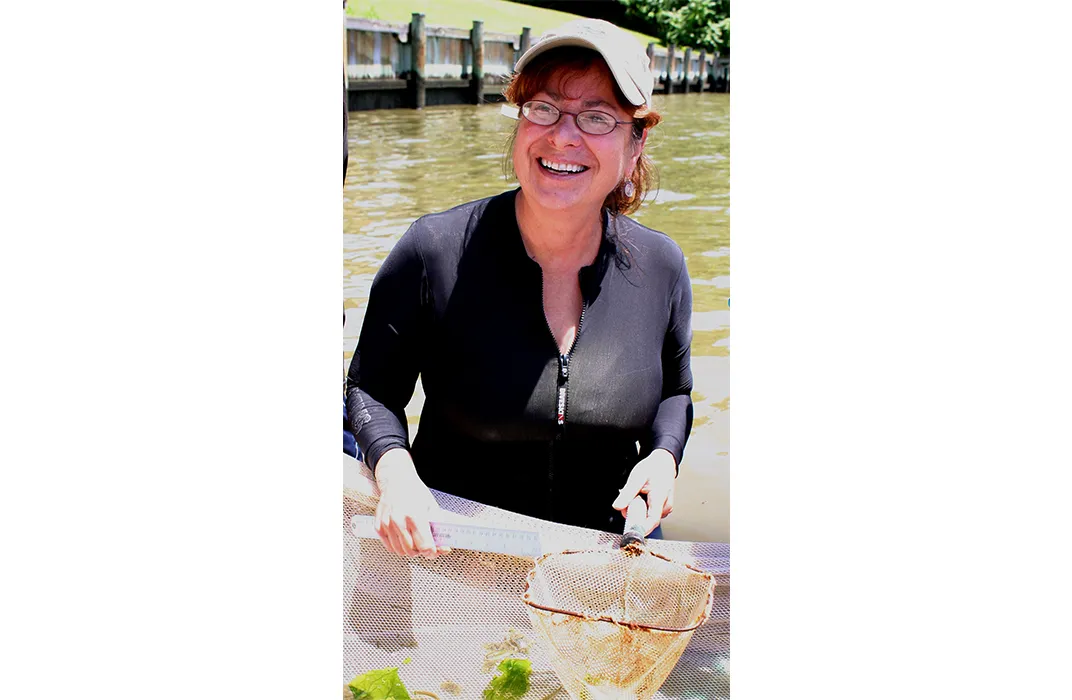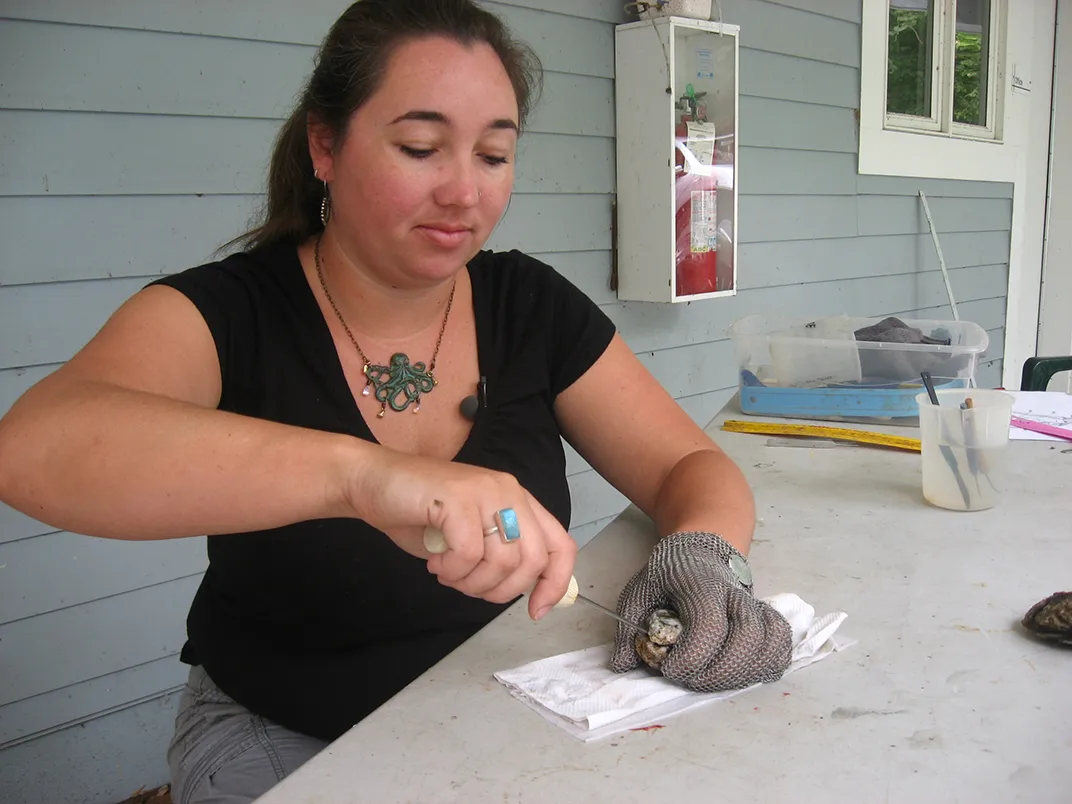Let Oysters Get Sick to Clean Up the Chesapeake
The delicious oyster you love to slurp might be the best bet for clearing away pollutants
/https://tf-cmsv2-smithsonianmag-media.s3.amazonaws.com/filer/9e/12/9e128f90-76e1-4a06-bb0e-57fb6fd45e42/42-20732527web.jpg)
If you’re trying to restore native oysters (Crassostrea virginica) in the Chesapeake Bay, you might try putting them in an environment where they’re most likely to get sick. The caveat: you must plant enough of them to “clean house.”
That’s just one idea implied by a study from Smithsonian scientist Denise Breitburg, who examined the effects of low oxygen on an oyster-crippling disease called Dermo (Perkinsus marinus). The single-celled parasite that infects an oyster’s blood is native to the Chesapeake Bay, and when oysters were abundant, the disease had little effect on the population as a whole. But after more than a century of overharvesting, habitat loss and increasing water pollution, oysters have dwindled to a mere one to two percent of their historic numbers. Dermo is now yet another blow decimating the once plentiful crown jewel of the Bay.
Efforts to restore oysters include spreading shells loaded with spat (baby oysters) into the water, ideally in places where they’re expected to thrive. Breitburg’s work, which was released today in the journal PLoS One, hints at a counter-intuitive option by revealing new dynamics between oysters and their environment.
It has long been thought that shallow, near-shore waters provide a refuge from the oxygen deprivation animals experience in dead zones. These vast areas of low-oxygen water occur in locations farther from shore and can sometimes persist for weeks or even months. Very little can survive in such conditions, hence the name.

While not subject to the extended low oxygen seen in dead zones, the shallows are not immune to periods of oxygen deprivation. Breitburg’s latest work indicates that near-shore waters may not provide absolute relief from these suffocating effects. “We’re finding that low oxygen, even if it’s occurring for a couple of hours out of the day, may have very strong effects on organisms in the system,” Breitburg says.
In the shallows, a constant supply of nutrients flow from the land and spur the growth of algae or phytoplankton, which in turn produce oxygen through photosynthesis during the day. At night, however, the story changes. Although photosynthesis stops, organisms in the water continue to respire and oxygen levels drop, sometimes dramatically. As the algae die, the process of decay draws oxygen levels down even further.
These day-night cycles are natural, but human activity is amplifying them as runoff from development and farmland and discharges from sewage treatment plants pump nutrients into the water and fuel an over-abundance of algae.

Through a series of field and lab experiments, Breitburg found that oysters in areas with the largest swings in day-night oxygen levels are far more prone to contracting Dermo. What’s more, the disease spreads more vigorously in such areas. “We found that daily exposure to low dissolved oxygen could, in some cases, double or even triple the rates of acquiring Dermo,” she says. “It also led to more severe infections and reduced growth rates of oysters.”
While researchers knew that the parasite thrives in conditions of high temperature and salinity, but this is the first evidence for the effects of nighttime low oxygen on the prevalence of the disease. Breitburg began her investigation with field experiments in areas where Dermo was already known to exist. She suspended hundreds of oysters—some infected, some not—in the water at 14 sites. After four months, she found that wherever nighttime low oxygen was more extreme, 100 percent of her uninfected oysters had contracted the parasite. In previously infected oysters, the disease advanced to more intense levels at sites with both low oxygen and high salinity.

Back at the Smithsonian Environmental Research Center’s wetlab, Breitburg developed a controlled experiment that came to be known as the “Room of DOOM,” for Dissolved Oxygen Oyster Mortality. There she exposed oysters to varying levels of cyclical low oxygen to mimic the day-night swings seen in the field. Within the first year of the experiment, young oysters exposed to low oxygen were nearly three times as likely to become infected with the parasite as their counterparts with consistently healthy oxygen exposure.
She’s not yet sure what’s going on. It may be that the animals were more stressed—the way a chronic stressor makes people more vulnerable to illness. What she can say, though is that their feeding habits changed. As oxygen levels dropped oysters slowed down, closed up and stopped feeding. But when oxygen levels returned, they went all out, sometimes feeding more than they would have had they not spent hours “holding their breath.”
“They’re probably not trying to make up for lost feeding opportunities,” Breitburg says. “We think they’re probably repaying their oxygen debt. But an oyster uses its gills both for feeding and for getting oxygen, so increased water movement over the gills ends up in increased feeding.”
Breitburg thinks the increased daytime feeding suggests that rather than avoiding areas with chronic nighttime low-oxygen, oyster restoration projects might want to seek them out. The conditions might make them more vulnerable to disease, but it also makes them more effective at filtering the water during the day when phytoplankton are growing.
Because Dermo can take a couple of years to kill an oyster, the mollusks may have plenty of time to clean the water and tip the environment in their favor.
“This kind of hypoxia (low oxygen) is particularly prevalent in really shallow water,” Breitburg says, “All of our work occurred in less than two meters, at a water depth where oyster filtration could potentially reach the whole water column. If you just put out a few oysters under these conditions, they’re not going to do a whole lot to change the amount of phytoplankton in the water and the amount of hypoxia that develops. But if you put enough oysters out that they’re filtering the water—reducing phytoplankton biomass—they might be able to change water quality from conditions that are harmful to conditions that are no longer harmful. It may help to guide the scale of restoration that’s needed to both produce sustainable oyster populations and also improve water quality.”
